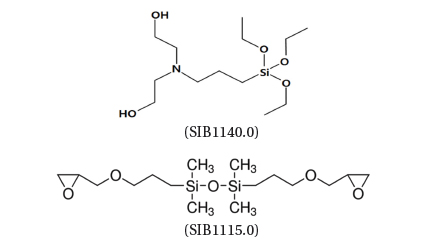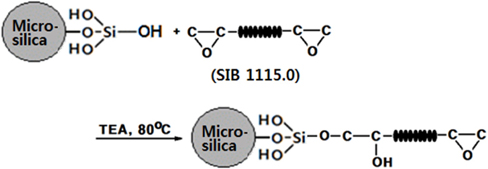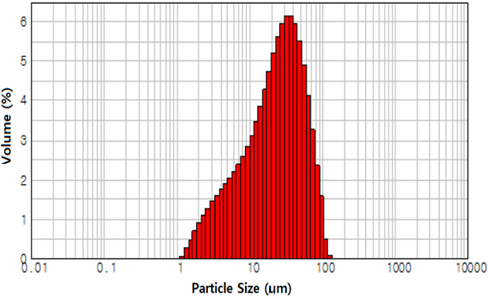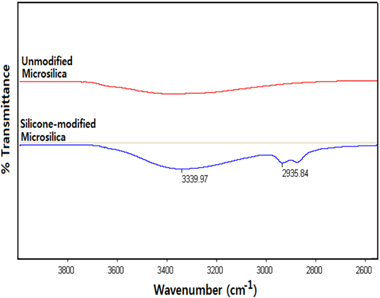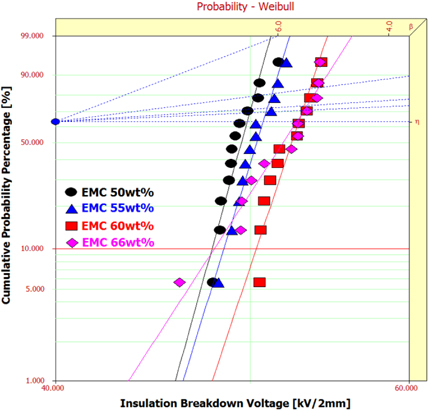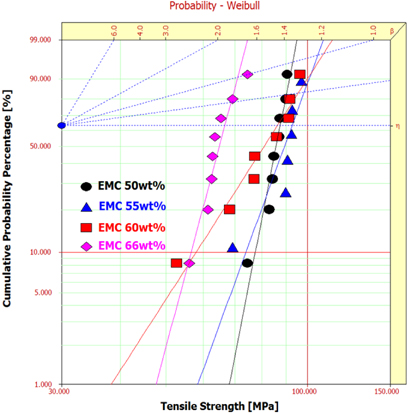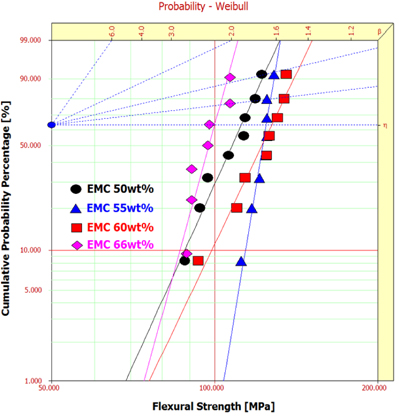



Various polymers have been used for electrical insulators in electrical equipment. Epoxy resins were the first polymers used as substitutes for conventional ceramic materials in applications such as mold-type transformers, current transformers (CT), potential transformers (PT), metering out-fit (MOF), and gas switching gears since mid-1940s [1-3]. These materials are still used to make electrical insulators for indoor and outdoor applications because they have good mechanical and thermal properties as well as excellent electrical properties [4,5].
Specifically, cycloaliphatic epoxy families have been used for outdoor applications because aliphatic cyclic structures are superior [1]to aromatic bisphenol structures in the resistance to UV radiation, carbon formation and surface discharges. The inherent low viscosity of these aliphatic cyclic epoxies enables them to be formulated with high levels of inorganic fillers [6]. Generally, 65 wt% ~ 80 wt% of micro-sized silica are incorporated into epoxy matrix in order to satisfy the dimensional stability of heavy electric equipment.
Carboxylic acid anhydrides are commonly used hardeners for the epoxy resins in these applications due to longer working time, [2]lower exothermic heat, lower processing viscosities and moderate to high glass transition temperatures. In order to make the reaction activation energy lower, tertiary amines are commonly used.
The performance of the epoxy/silica microcomposites is limited by high humidity levels and polluted environments because conductive pollutant layers lead to considerable reduction in insulation performances such as surface leakage current, arching and flashover. The effect of humidity and pollutants can be addressed by reducing the wettability of the surface or increasing the repellency to moisture and humidity by imparting hydrophobicity. In order to increase hydrophobicity, water repellents such as silicone oils are introduced to epoxy system [7,8].
In this study, the surface of microsilica was modified with silicone-modified epoxy and characterized by electrical breakdown tests, tensile and flexural tests of epoxy/microsilica composite using test specimens prepared through mixing microsilica with a cycloaliphatic epoxy resin. In order to examine the microcomposite effect for outdoor electrical insulator applications, the effect of microsilica content on the properties was studied.
An cycloaliphatic epoxy resin, diglycidyl 1,2-cyclohexanedicarboxylate (Araldite CY 184, Huntsman Co.) was used. The equivalent weight was 164~172 g/eq and the viscosity was 700~900 mPa·s at 25℃. An cycloaliphatic anhydride hardener, 4-methyl-1,2-cyclohexanedicarboxylic anhydride (Aradur HY 917, Huntsman Co.) was used. The anhydride content was ≥98% and the viscosity was 50~100 mPa·s at 25℃. A tertiary amine, benzyldimethyl amine (DY 062, Huntsman Co.) was used as an accelerator. Their chemical structures are as follows:
Bis(2-hydroxylethyl)-3-aminopropyltriethoxysilane (SIB1140.0, silane coupling agent) and 1,3-Bis(glycidoxypropyl) tetramethyl- disiloxane (SIB1115.0, silicone-modified epoxy) were purchased from Gelest Inc. in order to modify the surface of microsilica. Their chemical structures were as follows:
Microsilica was purchased from Sibelco Korea whose trade name is MILLISIL® M10. The silica content was 95.5 wt%.
Silicone-modified microsilica was prepared by the following procedures: firstly, the surface of the microsilica was treated with hydroxyl type silane (SIB 1140.0) in the presence of H+ catalyst (acetic acid) in toluene/acetone (7/3 wt%) mixture solution at 80℃, as shown in Scheme 1. It was rinsed with toluene. Then, the hydroxyl group was reacted with an epoxy group of each epoxy-terminated silicone in the presence of triethylamine (TEA) in toluene/acetone (7/3 wt%) mixture solution at 80℃, as shown in Scheme 2. Finally, the product was rinsed with toluene and silicone-modified microsilica produced.
The particle size of silicone-modified microsilica was analyzed by Mastersizer 2000 (Malvern Instruments) and it was found that the particle size ranged from 1.10 μm to 138.0 μm and the average particle size was 21.1 μm, as shown in Fig. 1.
Microsilica was in variety of irregular particle shapes and sizes with the rough and sharp morphology, which was shown in this paper. The morphology was observed by a Field emission scanning electron microscopy (FE-SEM, JMS-6701F, JEOL) at an acceleration voltage of 10 kV.
In order to confirm the silicone-modification on the microsilica surface, FT-IR analysis was carried out at a resolution of 4 cm−1 from 3,800 cm−1 to 2,600 cm−1. The characteristic bands for CH bond from silicone-modified epoxy were shown at 2,935 cm−1 and 2,853 cm−1, as shown in Fig. 2.
Epoxy base resin (CY 184, 100 g), curing agent (HY 917, 90 phr) and accelerator (DY 062, 0.6 phr) were well mixed using a mechanical stirrer. And in order to prepare epoxy/microsilica composite, silicone-modified microsilica (50, 55, 60, and 66 wt%) was homogeneously mixed with epoxy/curing agent/accelerator system for 3 hr. The unit phr meant the part per one hundred gram of epoxy base resin.
Sphere to sphere electrodes were arranged to be 2 mm insulation thickness to measure the ac insulation breakdown strength. The electrodes were made of copper and their diameters were 7.40 mm. And then, the specimen and electrodes were dipped into insulating oil of 25℃ and HV was applied by AC Endurance Voltage Tester (Haefely, Germany) at a rising speed of 1 kV/s until the electrical breakdown took place. The specification of the HV generator was as follows: it was controlled at the frequency of 60 Hz with the maximum voltage of 400 kV. The secondary maximum current was 1,000 mA with a system of 400 kVA. The data of voltage, current and frequency were collected every 5 seconds. All the data were estimated by Weibull statistical analysis [7].
Tensile and flexural tests were carried out by universal testing machine (SHM-C-500, Shamhan Tech, Korea). The former was carried out under the recommendation of JIS B7502 at a crosshead speed of 10 mm/min at 25℃ and 50% relative humidity and the latter was done by three point bending method with the recommendation of JIS B7507 with the span length of 50 mm and crosshead speed of 10 mm/min at the same temperature and humidity in the tensile test.
Weibull statistical analyses for AC insulation breakdown strength of epoxy/silicone-modified microsilica composites with 4 different microsilica contents are displayed in Fig. 3. The shape and scale parameters and B10 value were obtained from the Weibull plots and listed in Table 1. The shape parameter could be obtained from the slope to demonstrate the data distribution, and the scale parameter represented the tensile strength by which 63.2% of the cumulative probability was expected to break. The B10 value referred to the electrical breakdown strength at which 10% may break (90% would survive) under an applied high voltage [7]. The scale parameter increased until 60 wt% silica and decreased subsequently after that point. The maximum electrical breakdown strength, 52.84 kV/2 mm, was shown in the 60 wt% silica system 106.1% higher than the 55 wt% silica system and 100.2% higher value than the 66 wt% silica system. This indicates that well dispersed microsilica particles effectively interrupted the propagation of the electrical trace. However, excessive silica content results in a detrimental effect on the electrical breakdown of epoxy/silicone-modified microsilica composite.

Weibull parameters for electrical breakdown strength in epoxy/silicone-modified microsilica composite obtained from Fig. 3.
Figure 4 shows Weibull plots for tensile strength of epoxy/silicone-modified microsilica composites with different silica content, and the resulting Weibull parameters were obtained. The statistical analysis showed that scale parameter of epoxy/silicone-modified microsilica (55 wt%) to be 92.72 MPa with the shape parameter of 9.95. The epoxy/silicone-modified microsilica (66 wt%) was 66.69 MPa with the shapeparameter of 13.6. B10 value for epoxy/silicone-modified microsilica (55 wt%) was 74.13 MPa which is 131% higher value than the epoxy/silicone-modified microsilica (66 wt%) value of 56.54 MPa. The B10 value referred to the tensile strength at which 10% would break (90% would survive) [7]. When microsilica was added to an epoxy matrix, the silica can anchor the epoxy chains by covalent bonding and hydrogen bonding so that the mobility of the epoxy chains is disturbed, and therefore the tensile strength increases. As the filler content increased, the surface area increases so that the bonding density increases and therefore mechanical strength increases.

Weibull parameters for tensile strength in epoxy/silicone-modified microsilica composite are obtained from Fig 4.
Weibull plots for flexural strength of epoxy/silicone-modified microsilica composites with different microsilica content was shown in Fig. 5 and the Weibull parameters were listed in
Weibull parameters for flexural strength in epoxy/silicone-modified microsilica composite obtained from Fig. 5.
The same tendency was obtained and the maximum value, 127.47 MPa was obtained from the epoxy/silicone-modified microsilica (60 wt%) composite.
An Epoxy/silicone-modified microsilica composite for outdoor electrical insulator applications was prepared by mixing a cycloaliphatic epoxy resin (diglycidyl 1,2-cyclohexanedicarboxylate), a curing agent (4-methyl-1,2-cyclohexanedicarboxylic anhydride) and silicone-modified microsilica (50 wt%, 55 wt%, 60 wt%, and 66 wt%). Electrical and mechanical properties were investigated and as silicone-modified microsilica content increased, electrical breakdown strength and flexural strength increased until 60 wt% silica and decreased afterthat point. Tensile strength increased until 55 wt% silica content. In epoxy/silicone-modified microsilica (60 wt%) composite, electrical breakdown strength was determinde to be 52.84 kV/2 mm.

